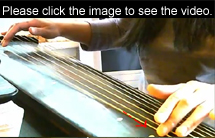|
| |
| The pictures shows the techniques using the thumb, but the techniques can also be perform using the index, middle and ring fingers.
6 Basic Finger Techniques of The Left Hand: Click the pictures for videos. | |
 |
Notation: Name: Yín 吟 Explanation: A vibrato movement. A finger of the left hand presses down a string, and after a finger of the right hand plays the string, the left hand quickly moves down (to the left) and up, 2 to 3 times and back to the spot one started with. The strength of this movement is strong at the beginning but gradually reducing at the end. The distance between each up and down is not bigger than 1/5 of the distance to the next Hui position. |
 |
Notation: Name: Náo 猱 Explanation: A vibrato movement. A finger of the left hand presses down a string, and after a finger of the right hand plays the string, the left hand quickly moves up (to the right) and down, 2 to 3 times and back to the spot one started with. The strength of this movement is strong at the beginning but gradually reducing at the end. The distance between each up and down is not bigger than 1/4 of the distance to the next Hui position. |
 |
Notation: Name: Chùo 綽 Explanation: A finger of the left hand, before pressing down a string on the indicated spot, starts about 5cm. below (to the left) of that spot, and quickly glides to the right, till the place indicated is reached. |
 |
Notation: Name: Zhù 注 Explanation: It is the opposite of Chùo. The movement starts about 5cm. above (to the right) of the indicated spot, and quickly glides to the left, till the place indicated is reached. |
 |
Notation: Name: Shàng (ascending) 上 Explanation: While the right hand plucks the string that the left hand has pressed down, the left hand glides up to the spot that is indicated. The pressing and moving of the left hand should be solid so that it will create a very clear sound. If there is one ascending after another ascending, the notation will be "二上" (Èr Shàng , up twice). In Guqin tableture, only the final destination of Èr Shàng is indicated. So the player has to listen to the tone and move his or her finger up to a proper position for the first ascending tone. Each ascending tone is approximately one whole step, for example, Do- Re- Mi, or Re-Mi-Sol, or Mi- Sol- La, or Sol-La-Do, or La-Do-Re. |
 |
Notation: Name: Xià (descending) 下 Explanation: opposite of "Shàng." While the right hand plucks the string that the left hand has pressed down, the left hand glides down to the spot that it is indicated. If there is one descending after another descending, the notation will be "二下" (Èr Xià, down twice). Same as Èr Shàng that the tableture only indicate the final desitination. So the player has to listen to the tone and move his or her finger down to a proper position for the first descending tone. Each descending tone is approximately one whole step. For example, Do- La- Sol, or La- Sol- Mi, or Sol- Mi-Re, or Mi- Re- Do, or Re- Do- La. |
| The Variations of Yín and Náo: Notation:  Name: Cháng Yin 長吟 Name: Cháng Yin 長吟Explanation: A drawn-out vibrato movement. The frequency of up and down is several times more than Yín. The total number can be 7 to 12 times of the frequency. Notation:  Name: Xì Yín 細吟 Name: Xì Yín 細吟Explanation: A thin vibrato movement, more delicate than Yín. Notation:  Name: Dìng Yín 定吟 Name: Dìng Yín 定吟Explanation: A calm vibrato. It is rocking the string back and force without moving the finger. Notation:  Name: Yóu Yín 游吟 Name: Yóu Yín 游吟Explanation: Swinging vibrato. Similar to Shuang Zhùang (see Shuang Zhuang on next page) but slower. Notation:  Name: Lùo Zhĭ Yín 落指吟 Name: Lùo Zhĭ Yín 落指吟Explanation: Immediately vibrato. Do Yín as soon as the left hand presses the string and the right hand plays the string. Notation:  Name: Lùe Yín 略吟 Name: Lùe Yín 略吟Explanation: Slightly Yín. Notation:  Name: Cháng Náo 長猱 Name: Cháng Náo 長猱Explanation: The movement is the same as Náo but the timing of the vibrato is longer. Same situation as Cháng Yín. Notation:  Name: Jí Náo 急猱 Name: Jí Náo 急猱Explanation: A fast Náo. Feels tight and rapid but not in a hurry. Notation:  Name: Lùo Zhĭ Náo 落指猱 Name: Lùo Zhĭ Náo 落指猱Explanation: Same situation as Lùo Zhĭ Yín. Do Náo as soon as the left hand presses the string and the right hand plays the string. Notation:  Name: Lùe Náo 略猱 Name: Lùe Náo 略猱Explanation: Slightly Náo. For a further study on distinguish the differences between Yín and Náo and a short film of the demo, please visit here.
| |